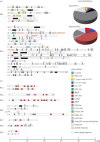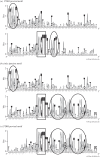Functional endogenous viral elements in the genome of the parasitoid wasp Cotesia congregata: insights into the evolutionary dynamics of bracoviruses
- PMID: 23938757
- PMCID: PMC3758192
- DOI: 10.1098/rstb.2013.0047
Functional endogenous viral elements in the genome of the parasitoid wasp Cotesia congregata: insights into the evolutionary dynamics of bracoviruses
Abstract
Bracoviruses represent the most complex endogenous viral elements (EVEs) described to date. Nudiviral genes have been hosted within parasitoid wasp genomes since approximately 100 Ma. They play a crucial role in the wasp life cycle as they produce bracovirus particles, which are injected into parasitized lepidopteran hosts during wasp oviposition. Bracovirus particles encapsidate multiple dsDNA circles encoding virulence genes. Their expression in parasitized caterpillars is essential for wasp parasitism success. Here, we report on the genomic organization of the proviral segments (i.e. master sequences used to produce the encapsidated dsDNA circles) present in the Cotesia congregata parasitoid wasp genome. The provirus is composed of a macrolocus, comprising two-thirds of the proviral segments and of seven dispersed loci, each containing one to three segments. Comparative genomic analyses with closely related species gave insights into the evolutionary dynamics of bracovirus genomes. Conserved synteny in the different wasp genomes showed the orthology of the proviral macrolocus across different species. The nudiviral gene odv-e66-like1 is conserved within the macrolocus, suggesting an ancient co-localization of the nudiviral genome and bracovirus proviral segments. By contrast, the evolution of proviral segments within the macrolocus has involved a series of lineage-specific duplications.
Keywords: bracovirus; comparative genomics; obligatory mutualism; parasitoid wasp; polydnavirus.
Figures








Similar articles
-
Genome-Wide Patterns of Bracovirus Chromosomal Integration into Multiple Host Tissues during Parasitism.J Virol. 2021 Oct 27;95(22):e0068421. doi: 10.1128/JVI.00684-21. Epub 2021 Jul 28. J Virol. 2021. PMID: 34319152 Free PMC article.
-
The bracovirus genome of the parasitoid wasp Cotesia congregata is amplified within 13 replication units, including sequences not packaged in the particles.J Virol. 2013 Sep;87(17):9649-60. doi: 10.1128/JVI.00886-13. Epub 2013 Jun 26. J Virol. 2013. PMID: 23804644 Free PMC article.
-
Functional annotation of Cotesia congregata bracovirus: identification of viral genes expressed in parasitized host immune tissues.J Virol. 2014 Aug;88(16):8795-812. doi: 10.1128/JVI.00209-14. Epub 2014 May 28. J Virol. 2014. PMID: 24872581 Free PMC article.
-
When parasitic wasps hijacked viruses: genomic and functional evolution of polydnaviruses.Philos Trans R Soc Lond B Biol Sci. 2013 Aug 12;368(1626):20130051. doi: 10.1098/rstb.2013.0051. Print 2013 Sep 19. Philos Trans R Soc Lond B Biol Sci. 2013. PMID: 23938758 Free PMC article. Review.
-
Unfolding the evolutionary story of polydnaviruses.Virus Res. 2006 Apr;117(1):81-9. doi: 10.1016/j.virusres.2006.01.001. Epub 2006 Feb 3. Virus Res. 2006. PMID: 16460826 Review.
Cited by
-
The genome of the nucleopolyhedrosis-causing virus from Tipula oleracea sheds new light on the Nudiviridae family.J Virol. 2015 Mar;89(6):3008-25. doi: 10.1128/JVI.02884-14. Epub 2014 Dec 24. J Virol. 2015. PMID: 25540386 Free PMC article.
-
Genomic architecture of endogenous ichnoviruses reveals distinct evolutionary pathways leading to virus domestication in parasitic wasps.BMC Biol. 2020 Jul 24;18(1):89. doi: 10.1186/s12915-020-00822-3. BMC Biol. 2020. PMID: 32703219 Free PMC article.
-
Genome-Wide Patterns of Bracovirus Chromosomal Integration into Multiple Host Tissues during Parasitism.J Virol. 2021 Oct 27;95(22):e0068421. doi: 10.1128/JVI.00684-21. Epub 2021 Jul 28. J Virol. 2021. PMID: 34319152 Free PMC article.
-
Microplitis demolitor Bracovirus Proviral Loci and Clustered Replication Genes Exhibit Distinct DNA Amplification Patterns during Replication.J Virol. 2015 Sep;89(18):9511-23. doi: 10.1128/JVI.01388-15. Epub 2015 Jul 8. J Virol. 2015. PMID: 26157119 Free PMC article.
-
The bracovirus genome of the parasitoid wasp Cotesia congregata is amplified within 13 replication units, including sequences not packaged in the particles.J Virol. 2013 Sep;87(17):9649-60. doi: 10.1128/JVI.00886-13. Epub 2013 Jun 26. J Virol. 2013. PMID: 23804644 Free PMC article.
References
-
- Herniou EA, Huguet E, Thézé J, Bézier A, Periquet G, Drezen J-M. 2013. When parasitic wasps hijacked viruses: genomic and functional evolution of polydnaviruses. Phil. Trans. R. Soc. B 368, 20130051 (doi:10.1098/rstb.2013.0051) - DOI - PMC - PubMed
-
- Dupuy C, Huguet E, Drezen J-M. 2006. Unfolding the evolutionary story of polydnaviruses. Virus Res. 117, 81–89 (doi:10.1016/j.virusres.2006.01.001) - DOI - PubMed
-
- Murphy N, Banks JC, Whitfield JB, Austin AD. 2008. Phylogeny of the parasitic microgastroid subfamilies (Hymenoptera: Braconidae) based on sequence data from seven genes, with an improved time estimate of the origin of the lineage. Mol. Phylogenet. Evol. 47, 378–395 (doi:10.1016/j.ympev.2008.01.022) - DOI - PubMed
-
- Bézier A, et al. 2009. Polydnaviruses of braconid wasps derive from an ancestral nudivirus. Science 323, 926–930 (doi:10.1126/science.1166788) - DOI - PubMed
-
- Théze J, Bézier A, Periquet G, Drezen J-M, Herniou EA. 2011. Paleozoic origin of insect large dsDNA viruses. Proc. Natl Acad. Sci. USA 108, 15 931–15 935 (doi:10.1073/pnas.1105580108) - DOI - PMC - PubMed
Publication types
MeSH terms
Substances
Associated data
- Actions
- Actions
- Actions
- Actions
- Actions
- Actions
- Actions
- Actions
- Actions
LinkOut - more resources
Full Text Sources
Other Literature Sources

